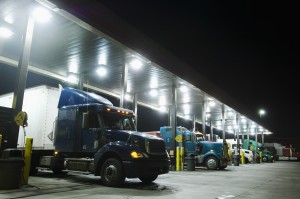Anyone who has ever traveled any significant distance on a major highway has probably passed by a weigh station. While weigh stations are commonly found throughout the nation, many aren’t familiar with how they operate or what their purpose is.
Weigh stations serve two purposes for most states. Their purpose is to monitor the weight of freight being transported for both tax purposes and safety purposes. When trucks carrying freight enter a weigh station, they are being weighed in two different ways. The first way is through their gross weight, which is each of their axles combined for a total weight. The second way is through axle weight, which is the amount each axle is carrying in weight. From state to state, the maximum total weight for freight being carried changes, but a standard weight that is commonly used throughout the nation is 34,000 pounds. Scales are created to withstand the stress of weighing heavy trucks throughout the course of a day while taking accurate measurements each time. Some systems that are used in weigh stations include:
- Load-Cell: This is the most commonly found form of technology used throughout weigh stations. The cells used on the scale system are created by a strong and durable material that includes a strain gauge. This gauge is changed once weight is applied, which allows sensors to determine the weight amount.
- Piezoelectric- This system is based on conductor sensors that use electrical charges to determine a weight amount.
- Bending-Plate- This system places stress on different metal plates to determine the total weight of each axel on the vehicle.
Along with the different systems used in weigh stations, there are also different techniques and methods used in weigh stations as well.
- Weigh-in-motion: A newer method that is gaining popularity in weigh stations, this method allows a truck to drive over a pad that includes sensors that are able to weigh the truck. This means that the truck would not be made to stop while passing through the weigh stations.
- One-axel: This method includes a truck driving over a scale. As each set of wheels reaches the scale, the truck must stop so the weight can be measured.
- One-stop: This method allows a truck to be weighed by only stopping once along a series of different scales.
Evan Transportation was founded in 1992 by Jerry Wolfarth, who at the time had over 25 years of experience in the trucking and transportation industry. The initial operation consisted of a few trucks and drivers who were dedicated and professional. The goal of the company was, and remains, to provide excellent, dependable service.
Contact us today for all of your freight shipment needs or call us at 443-673-3365. We will discuss your tractor trailer options for the freight you wish to ship.
Before you hit the road, check us out on Facebook, Twitter, Google+, LinkedIn and YouTube!
Source:
http://science.howstuffworks.com/engineering/civil/question626.htm

